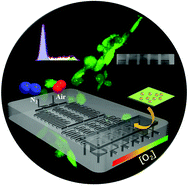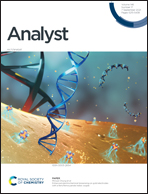Three dimensionally printed nitrocellulose-based microfluidic platform for investigating the effect of oxygen gradient on cells†
Abstract
In this article, we present a novel nitrocellulose-based microfluidic chip with 3-dimensional (3D) printing technology to study the effect of oxygen gradient on cells. Compared with conventional polydimethylsiloxane (PDMS) chips of oxygen gradient for cell cultures that can only rely on fluorescence microscope analysis, this hybrid nitrocellulose-based microfluidic platform can provide a variety of analysis methods for cells, including flow cytometry, western blot and RT-PCR, because the nitrocellulose-based chips with cells can be taken out from the growth chambers of 3D printed microfluidic chip and then used for cell collection or lysis. These advantages allow researchers to acquire more information and data on the basic biochemical and physiological processes of cell life. The effect of oxygen gradient on the zebrafish cells (ZF4) was used as a model to show the performance and application of our platform. Hypoxia caused the increase of intercellular reactive oxygen species (ROS) and accumulation of hypoxia-inducible factor 1α (HIF-1α). Hypoxia stimulated the transcription of hypoxia-responsive genes vascular endothelial growth factor (VEGF) and induced cell cycle arrest of ZF4 cells. The established platform is able to obtain more information from cells in response to different oxygen concentration, which has potential for analyzing the cells under a variety of pathological conditions.

- This article is part of the themed collection: Analyst HOT Articles 2021


 Please wait while we load your content...
Please wait while we load your content...